












|
 |
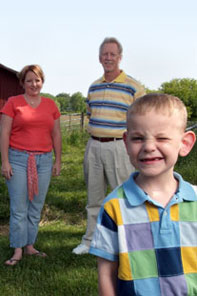 |
 ix-year-old
Cody Hardin, his mom, and his granddad have more than blood in
common. They share a love of sports, a passion for riding four-wheelers
across the woods near their family home in Kingston, Georgia,
and the abnormal gene for fragile X. Cody was only 2 when April
Hardin, a nurse, started looking for answers for her son’s
slowness to speak, his distress at unexpected happenings, his
hand flapping, and rocking. At the suggestion of a speech therapist,
Hardin had her son tested for fragile X syndrome, the most frequently
inherited form of mental retardation, which affects one in 4,000
males and one in 8,000 females. At age 3, he was confirmed to
have the mutated gene and the syndrome. ix-year-old
Cody Hardin, his mom, and his granddad have more than blood in
common. They share a love of sports, a passion for riding four-wheelers
across the woods near their family home in Kingston, Georgia,
and the abnormal gene for fragile X. Cody was only 2 when April
Hardin, a nurse, started looking for answers for her son’s
slowness to speak, his distress at unexpected happenings, his
hand flapping, and rocking. At the suggestion of a speech therapist,
Hardin had her son tested for fragile X syndrome, the most frequently
inherited form of mental retardation, which affects one in 4,000
males and one in 8,000 females. At age 3, he was confirmed to
have the mutated gene and the syndrome.
Around the time of Cody’s
birth, April’s father, Joe Pratt, was experiencing health
problems of his own. The 52-year-old businessman and high school
basketball official developed a tremor that prevented him from
lifting fork to mouth. At first, physicians in Chattanooga, where
Pratt lives, diagnosed Parkinson’s disease. However, after
Cody’s condition surfaced, Pratt underwent genetic testing
along with his daughter. It turned out that April Hardin is among
the one out of every 259 women who carry the abnormal gene, which
she inherited from Pratt.
The news was devastating to the
family and particularly to the doting grandfather. Until a few
years ago, grandfathers were not tested for fragile X. Since carriers
evidence none of the symptoms of their affected offspring, testing
had been offered only to family members at risk for having a fragile
X child. But observations of seemingly related health problems
by the family members themselves pointed fragile X researchers
down a different path. They have found that one in five female
carriers of the fragile X gene—but not those with the syndrome—have
early menopause. Working on that research front, Emory geneticist
Stephanie Sherman is studying premature ovarian failure in carriers.
Researchers also found that some male fragile X carriers develop
neurologic or neuropsychologic problems in their 50s or 60s, a
new disease they called fragile X tremor ataxia syndrome (FXTAS).
Genetic and neurologic testing clearly
indicated that Pratt has FXTAS rather than Parkinson’s.
While the grandfather is not cured, he is back on the basketball
court, thanks to recommendations by an Emory neurologist. He also
has joined his daughter and grandson in Emory’s research
programs.
“I’m doing this for
Cody,” Pratt says. “Anything to help them hurry and
find a treatment to give him as normal a life as possible.”
|
 |
|
 |
 |
 |
|
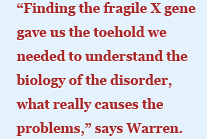 |


 tephen
Warren, chair of Emory’s Department of Human Genetics, and
his colleagues have indeed been in a hurry. In 1991, Warren led
the international research team that discovered the fragile X
gene responsible for the syndrome. He was among the first to develop
genetic tests to diagnose the disease in children and predict
the possibility of having a child affected by the disease. He
now heads the world’s single largest NIH-funded fragile
X research program, one that has mapped in detail the molecular
as well as the clinical consequences of the fragile X gene mutation. tephen
Warren, chair of Emory’s Department of Human Genetics, and
his colleagues have indeed been in a hurry. In 1991, Warren led
the international research team that discovered the fragile X
gene responsible for the syndrome. He was among the first to develop
genetic tests to diagnose the disease in children and predict
the possibility of having a child affected by the disease. He
now heads the world’s single largest NIH-funded fragile
X research program, one that has mapped in detail the molecular
as well as the clinical consequences of the fragile X gene mutation.
“Finding the fragile X gene
gave us the toehold we needed to understand the biology of the
disorder, what really causes the problems,” says Warren.
The team determined that the normal gene, the gene without the
fragile X mutation, produced a specific protein necessary to regulate
synthesis of other proteins involved in maintaining synapses between
neurons, connections that are the basis of learning and memory.
The damaged fragile X gene produces none of this regulatory protein,
resulting in lost synaptic connections. In an effort to compensate
for these lost connections, the brain signals the neurons to make
more and more of the various synaptic proteins. This acceleration
creates a protein overload, causing the dendrites of the neuron
to become more rigid and less able to respond, thereby disrupting
the cognitive process and possibly contributing to the behavioral
problems seen in fragile X syndrome.
In carriers, the fragile X gene
still produces this important protein, thus preventing the problems
seen in offspring who have fragile X syndrome. As Joe Pratt knows
firsthand, however, all carriers are not home free. Emory fragile
X researchers have discovered why. They identified a minuscule
difference—a series of triple repeats—in the fragile
X gene in carriers who develop FXTAS. All genes are made of combinations
of four chemicals, abbreviated A, C, G, and T. Within the fragile
X gene, the CGG, CGG, CGG grouping is repeated only 30 times in
unaffected people but between 230 and 1,000 times in those with
fragile X syndrome.
Since many FXTAS patients respond
to drugs developed for Parkinson’s disease, some clinicians
had expressed skepticism that FXTAS was really a different disorder.
That is, until Emory fragile X researcher Peng Jin placed the
repeat portion of the gene in normal fruit flies, resulting in
a sudden neurologic decline that definitively proved the impact
of the altered gene. Warren and Sherman now lead a large clinical
research group on the ataxia syndrome, seeking to more closely
define what changes occur and how best to combat them. |
 |
|
 |
 |
 |
|
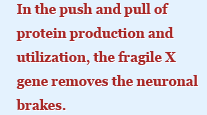 |


 he
good news for Cody Hardin and thousands of other families like
his is that Emory researchers now understand the function of fragile
X’s protein well enough to develop a drug that will help
compensate for the damaged gene’s effects. Warren hopes
to have such a drug in clinical trials within the next decade. he
good news for Cody Hardin and thousands of other families like
his is that Emory researchers now understand the function of fragile
X’s protein well enough to develop a drug that will help
compensate for the damaged gene’s effects. Warren hopes
to have such a drug in clinical trials within the next decade.
Once the investigators understood the sequence of events resulting
from the defective gene, they immediately saw where they could
intervene. In the push and pull of protein production and utilization,
the fragile X gene removes the neuronal brakes. The researchers
could compensate by finding a drug that takes the pressure off
the gas, the brain’s signal to the neuron to accelerate
production of more and more synaptic proteins.
The team already has identified
compounds that do that in fruit flies and mice. Although the human
body takes up these compounds imperfectly, chemists may be able
to manipulate them into useful drugs. That will take years however,
which neither the Emory team nor Cody Hardin’s grandfather
wants. Cody starts softball this year, and his family eagerly
hopes he can master the patience to wait on base until another
runner hits the ball.
To speed the process, Warren has
taken another road: his team is screening every drug ever approved
by the FDA, almost 2,000 of them, looking for one or more with
the same abilities as the compounds that have worked in the lab.
He is confident they will find a match, and when they do, he says,
with the safety and efficacy studies already complete, “we
can move rapidly into clinical trials with fragile X patients.”
While the new drug may fail to completely
reverse the cognitive deficit seen in children and adults with
fragile X syndrome, Warren thinks it may have a big impact on
behavioral problems that do so much to impede learning. “Fragile
X kids differ from children with other types of retardation,”
he notes. “While the basic cognitive deficits are often
less deep, their own behaviors distract them. You can look in
their eyes and see how sharp they are. They are aware that something
is wrong, and it pains them not to know how to make it right.”
While the researchers look for the
drug, they are using their clinical knowledge to focus on early
interventions shown to have a powerful impact on behavior and
learning, as they have done with young Cody. Because of the efficacy
of early intervention, not to mention the promise of an effective
drug, Warren hopes to see states like Georgia add fragile X testing
to the newborn screening panel.
|
 |
|
 |
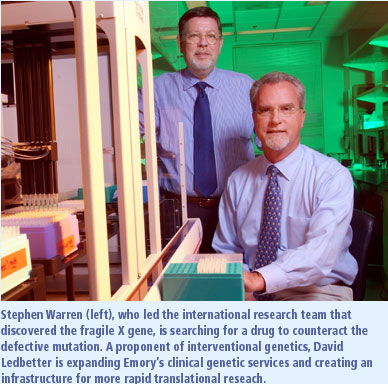 |
|
 |
 |
 |
|
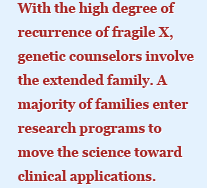 |


 lthough
Emory’s Department of Human Genetics is still young, in
fact, two years younger than Cody Hardin, already it has reorganized
the traditional approach to genetics. The conscious pairing of
clinical care and basic science research in genetics is a marked
departure from all but a handful of medical schools, according
to Warren. The department has incorporated the former basic science
genetics department, enfolded a long-standing medical genetics
program, formerly in pediatrics, and gathered faculty scattered
across campus to work together on patient care and translational
genetics. The situation is good for both groups: clinicians gain
access to expensive research tools, such as transgenic or knockout
mice, which they can use to manipulate and study genes, and basic
scientists are involved in clinical research with large numbers
of patients and families. lthough
Emory’s Department of Human Genetics is still young, in
fact, two years younger than Cody Hardin, already it has reorganized
the traditional approach to genetics. The conscious pairing of
clinical care and basic science research in genetics is a marked
departure from all but a handful of medical schools, according
to Warren. The department has incorporated the former basic science
genetics department, enfolded a long-standing medical genetics
program, formerly in pediatrics, and gathered faculty scattered
across campus to work together on patient care and translational
genetics. The situation is good for both groups: clinicians gain
access to expensive research tools, such as transgenic or knockout
mice, which they can use to manipulate and study genes, and basic
scientists are involved in clinical research with large numbers
of patients and families.
Since 2001, when Warren received
the go-ahead to create what he saw as the ideal human genetics
department, he has hired more than a dozen young professors, bringing
the faculty total to 33. One of his senior recruitments, David
Ledbetter, came to Emory from the University of Chicago, where
he served as genetics chair. As director of the Division of Medical
Genetics, Ledbetter is expanding Emory’s clinical genetic
services selectively and strategically, building on areas where
Emory has the basic science expertise to provide instant credibility
and creating the infrastructure for more rapid translational research.
The first clinical areas that are
benefiting from basic science input include general pediatric
genetics, adult genetics, and cancer genetics. For example, the
department’s metabolic disorders program already serves
as the referral center for Georgia’s newborn screening and
is responsible for genetic disease screening in six metro hospitals.
Now its clinical research protocols are growing as well, including
enzyme replacement trials for metabolic diseases such as Fabry’s
and Gaucher’s diseases. More evidence, says Ledbetter, of
the power of interventional genetics. These lysosomal storage
disorders are caused by a genetic defect that results in failure
to produce an enzyme required to metabolize specific molecules.
The subsequent accumulation of these molecules in the liver, spleen,
or brain is debilitating, often lethal. A few years ago, however,
scientists discovered that patients could be infused with the
missing enzyme every week or 10 days. Emory participated in the
clinical trial that resulted in FDA approval of the first and
only enzyme in use and currently is testing a number of other
enzymes for these and other diseases.
The department is opening new specialty
clinics too, for patients with Down syndrome and fragile X syndrome.
The national Down Syndrome Project and a national Fragile X Syndrome
Research Center are the largest programs of this kind in the nation.
Pediatric medical geneticists Paul Fernhoff (who is medical director
of the Division of Medical Genetics), Daniel Gruskin, or Margaret
Adam are the first stop for children who attend these clinics
to determine whether they have secondary medical problems that
require further referrals. Next, a developmental pediatrician
and geneticist assists parents in managing problems and guiding
them to educational resources and therapies. Parents also receive
counseling on recurrence risk. For Down syndrome patients, genetic
specialists determine the specific type of the disorder—a
significant finding for genetic counseling because some types
are more easily inherited than others. With the high degree of
recurrence of fragile X, genetic counselors involve the extended
family. A majority of families, including the Hardins, enter research
programs at Emory, doing what they can to move the science forward
to clinical applications. They may not be the only beneficiaries.
In an investigation of why some Down syndrome babies are born
with congenital heart disease while others are not, for example,
Stephanie Sherman is looking for DNA sequence differences in genes
she knows are important for heart development. Her findings of
possible mutations also may provide important clues, perhaps even
prenatal testing, for congenital heart disease in general. |
 |
|
 |
 |
 |
|
 |

 |
 |

 ragile
X is the most common known cause of autism, accounting for
2% to 5% of cases. The only other known cause, accounting
for 1% to 2% of cases, is duplication on chromosome 15,
the same region involved in Prader-Willi syndrome. While
Warren is the undisputed leader in fragile X research, Ledbetter
is the scientist who discovered the genetic basis of Prader-Willi.
Partnering with the autism center in Emory’s Department
of Psychiatry and the private Marcus Institute, these researchers
are applying their expertise to look for the unknown causes
of autism and, ultimately, the point at which they can intervene. ragile
X is the most common known cause of autism, accounting for
2% to 5% of cases. The only other known cause, accounting
for 1% to 2% of cases, is duplication on chromosome 15,
the same region involved in Prader-Willi syndrome. While
Warren is the undisputed leader in fragile X research, Ledbetter
is the scientist who discovered the genetic basis of Prader-Willi.
Partnering with the autism center in Emory’s Department
of Psychiatry and the private Marcus Institute, these researchers
are applying their expertise to look for the unknown causes
of autism and, ultimately, the point at which they can intervene.
“Autism is clearly not
caused by a single gene,” says Warren. “It may
take gene mutation plus an environmental trigger.”
To seek out such predisposing
changes, the human genetics research group is taking advantage
of the recently mapped human genome and high-throughput
robotic technologies unavailable even two or three years
ago. Ledbetter is a member of the steering committee of
the Autism Genetic Resource Exchange, a gene bank with pedigrees,
genomic scans, and/or DNA samples of almost 600 families
with more than one member diagnosed with autism spectrum
disorder. He and colleague Christa Martin take DNA from
these patients, label it with fluorescent dyes, and compare
it with the normal genome, looking for areas with duplications
or deletions.
Warren searches telltale genetic
signs of autism using the magnifying glass of what is already
known about genes that cause autism-like disorders when
severely mutated. For example, the X chromosome is a good
place to look, since five to nine times more males than
females have autism and the X chromosome contains a large
number of genes (including fragile X) that cause retardation
if severely mutated. With the faculty and technology now
in his laboratories, he is comparing this and other regions
of a normal human genome to that of people with autism,
looking for milder mutations.
“And when we find those
genes and what they do,” says Warren, “we will
have our entrance into autism, exactly as we found one with
fragile X. The next step will be to see where to intervene
to compensate for the effect of those genes. Only this time,
we will have the fragile X experience behind us, and it
won’t take as long to know what to do.” |
 |

 |
|
 |
|
 |
 |
 |
|
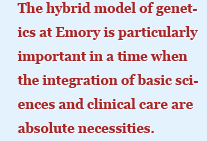 |


 o
accommodate its growth, the academic offices of human genetics
have doubled their space on campus. The majority of Emory’s
clinical and laboratory services in genetics are now clustered
a mile away in a 24,000-square-foot building on North Decatur
Road, modeled to fit the needs of families seen in the genetics
program and the researchers who work with them. The facility allows
easy access for patients and emphasizes patient privacy with a
separate entrance to clinician and counselor offices. It includes
a special foods store and demonstration kitchen for parents of
children with metabolic diseases and genetics laboratories (biochemistry,
molecular, and cytogenetics) that process more than 28,000 patient
specimens each year from across the nation. o
accommodate its growth, the academic offices of human genetics
have doubled their space on campus. The majority of Emory’s
clinical and laboratory services in genetics are now clustered
a mile away in a 24,000-square-foot building on North Decatur
Road, modeled to fit the needs of families seen in the genetics
program and the researchers who work with them. The facility allows
easy access for patients and emphasizes patient privacy with a
separate entrance to clinician and counselor offices. It includes
a special foods store and demonstration kitchen for parents of
children with metabolic diseases and genetics laboratories (biochemistry,
molecular, and cytogenetics) that process more than 28,000 patient
specimens each year from across the nation.
Slated to join the genetics enterprise
on North Decatur Road are the Center for Medical Genomics—where
blood is drawn, studied, and stored for genetic studies—and
an infusion center for patients with Fabry’s or Gaucher’s
disease.
“Genetics has always been
a bit of a hybrid,” says Warren. Because of the many years
during which genetic counseling was done largely by genetics professors,
it is the only field in which PhDs apply for postgraduate training
alongside MDs and are board-certified by the American Board of
Medical Specialties.
The hybrid model of genetics at
Emory today is particularly important in a time when the integration
of basic sciences and clinical care are absolute necessities for
translating genetics. These bridges between the laboratory and
the clinic, between PhDs and MDs, between doctors and patients,
are the ones that bring promise to 6-year-olds like Cody Hardin. |
 |
|
 |
 |
 |
|
 |
 |
 |
|
|
|
|





